Polarization and Incident Angle Independent Multifunctional and Multiband Tunable THz Metasurface Based on VO2
Abstract
1. Introduction
2. Structure Design and Simulation
3. Metasurface Performance
3.1. Performance of the Multifunctional (SFL) Metasurface as a Polarization Conversion
3.2. Performance of the Multifunctional (SFL) Metasurface as an Absorption
4. Potential Fabrication Process of Designed Metasurface
5. Conclusions
Author Contributions
Funding
Data Availability Statement
Conflicts of Interest
References
- Ferguson, B.; Zhang, X.-C. Materials for terahertz science and technology. Nat. Mater. 2002, 1, 26–33. [Google Scholar] [CrossRef] [PubMed]
- Chen, H.-T.; Padilla, W.J.; Zide, J.M.; Gossard, A.C.; Taylor, A.J.; Averitt, R.D. Active terahertz metamaterial devices. Nature 2006, 444, 597–600. [Google Scholar] [CrossRef] [PubMed]
- Qureshi, U.U.R.; Basir, S.; Ahmad, M.; Jalal, A.; Iqbal, R.; Khan, M.I. Realizing high-efficient multifunctional and tunable multiband THz metasurface for polarization and phase modulation. Optik 2024, 300, 171663. [Google Scholar] [CrossRef]
- Grady, N.K.; Heyes, J.E.; Chowdhury, D.R.; Zeng, Y.; Reiten, M.T.; Azad, A.K.; Taylor, A.J.; Dalvit, D.A.; Chen, H.-T. Terahertz metamaterials for linear polarization conversion and anomalous refraction. Science 2013, 340, 1304–1307. [Google Scholar] [CrossRef] [PubMed]
- Zeng, F.; Ye, L.; Li, L.; Wang, Z.; Zhao, W.; Zhang, Y. Tunable mid-infrared dual-band and broadband cross-polarization converters based on U-shaped graphene metamaterials. Opt. Express 2019, 27, 33826–33839. [Google Scholar] [CrossRef]
- Lin, R.; Lu, F.; He, X.; Jiang, Z.; Liu, C.; Wang, S.; Kong, Y. Multiple interference theoretical model for graphene metamaterial-based tunable broadband terahertz linear polarization converter design and optimization. Opt. Express 2021, 29, 30357–30370. [Google Scholar] [CrossRef] [PubMed]
- Xu, S.; Fan, F.; Cao, H.; Wang, Y.; Chang, S. Liquid crystal integrated metamaterial for multi-band terahertz linear polarization conversion. Chin. Opt. Lett. 2021, 19, 093701. [Google Scholar] [CrossRef]
- Li, J.; Zheng, C.; Li, J.; Wang, G.; Liu, J.; Yue, Z.; Hao, X.; Yang, Y.; Li, F.; Tang, T. Terahertz wavefront shaping with multi-channel polarization conversion based on all-dielectric metasurface. Photonics Res. 2021, 9, 1939–1947. [Google Scholar] [CrossRef]
- Jiang, Y.; Wang, L.; Wang, J.; Akwuruoha, C.N.; Cao, W. Ultra-wideband high-efficiency reflective linear-to-circular polarization converter based on metasurface at terahertz frequencies. Opt. Express 2017, 25, 27616–27623. [Google Scholar] [CrossRef]
- Tamayama, Y.; Yasui, K.; Nakanishi, T.; Kitano, M. A linear-to-circular polarization converter with half transmission and half reflection using a single-layered metamaterial. Appl. Phys. Lett. 2014, 105, 021110. [Google Scholar] [CrossRef]
- Yue, Z.; Li, J.; Zheng, C.; Li, J.; Chen, M.; Hao, X.; Xu, H.; Wang, Q.; Zhang, Y.; Yao, J. Manipulation of polarization conversion and multiplexing via all-silicon phase-modulated metasurfaces. Chin. Opt. Lett. 2022, 20, 043601. [Google Scholar] [CrossRef]
- Cheng, Y.; Wang, J. Tunable terahertz circular polarization convertor based on graphene metamaterial. Diam. Relat. Mater. 2021, 119, 108559. [Google Scholar] [CrossRef]
- Yao, G.; Ling, F.; Yue, J.; Luo, C.; Ji, J.; Yao, J. Dual-band tunable perfect metamaterial absorber in the THz range. Opt. Express 2016, 24, 1518–1527. [Google Scholar] [CrossRef] [PubMed]
- Sun, P.; You, C.; Mahigir, A.; Liu, T.; Xia, F.; Kong, W.; Veronis, G.; Dowling, J.P.; Dong, L.; Yun, M. Graphene-based dual-band independently tunable infrared absorber. Nanoscale 2018, 10, 15564–15570. [Google Scholar] [CrossRef] [PubMed]
- Chen, Z.; Weng, Y.; Liu, J.; Guo, N.; Yu, Y.; Xiao, L. Dual-band perfect absorber for a mid-infrared photodetector based on a dielectric metal metasurface. Photonics Res. 2021, 9, 27–33. [Google Scholar] [CrossRef]
- Xia, S.-X.; Zhai, X.; Huang, Y.; Liu, J.-Q.; Wang, L.-L.; Wen, S.-C. Multi-band perfect plasmonic absorptions using rectangular graphene gratings. Opt. Lett. 2017, 42, 3052–3055. [Google Scholar] [CrossRef] [PubMed]
- Wu, D.; Wang, M.; Feng, H.; Xu, Z.; Liu, Y.; Xia, F.; Zhang, K.; Kong, W.; Dong, L.; Yun, M. Independently tunable perfect absorber based on the plasmonic properties in double-layer graphene. Carbon 2019, 155, 618–623. [Google Scholar] [CrossRef]
- Jiang, L.; Yuan, C.; Li, Z.; Su, J.; Yi, Z.; Yao, W.; Wu, P.; Liu, Z.; Cheng, S.; Pan, M. Multi-band and high-sensitivity perfect absorber based on monolayer graphene metamaterial. Diam. Relat. Mater. 2021, 111, 108227. [Google Scholar] [CrossRef]
- Qureshi, U.U.R.; Hu, B.; Ahmad, M.; Jalal, A. Graphene-based triple-band tunable metasurface with strong circular dichroism for Hz communication. IEEE Photonics Technol. Lett. 2023, 35, 1375–1378. [Google Scholar] [CrossRef]
- Zhu, J.; Ma, Z.; Sun, W.; Ding, F.; He, Q.; Zhou, L.; Ma, Y. Ultra-broadband terahertz metamaterial absorber. Appl. Phys. Lett. 2014, 105, 021102. [Google Scholar] [CrossRef]
- Lei, L.; Li, S.; Huang, H.; Tao, K.; Xu, P. Ultra-broadband absorber from visible to near-infrared using plasmonic metamaterial. Opt. Express 2018, 26, 5686–5693. [Google Scholar] [CrossRef] [PubMed]
- Wang, B.; Ma, C.; Yu, P.; Govorov, A.O.; Xu, H.; Wang, W.; Besteiro, L.V.; Jing, Z.; Li, P.; Wang, Z. Ultra-broadband nanowire metamaterial absorber. Photonics Res. 2022, 10, 2718–2727. [Google Scholar] [CrossRef]
- Goldstein, D.H. Polarized Light; CRC Press: Boca Raton, FL, USA, 2017. [Google Scholar]
- Dorrah, A.H.; Rubin, N.A.; Zaidi, A.; Tamagnone, M.; Capasso, F. Metasurface optics for on-demand polarization transformations along the optical path. Nat. Photonics 2021, 15, 287–296. [Google Scholar] [CrossRef]
- Scully, M.O.; Zubairy, M.S. Quantum Optics; Cambridge University Press: Cambridge, UK, 1997. [Google Scholar]
- Demos, S.; Alfano, R. Optical polarization imaging. Appl. Opt. 1997, 36, 150–155. [Google Scholar] [CrossRef] [PubMed]
- Tyo, J.S.; Goldstein, D.L.; Chenault, D.B.; Shaw, J.A. Review of passive imaging polarimetry for remote sensing applications. Appl. Opt. 2006, 45, 5453–5469. [Google Scholar] [CrossRef] [PubMed]
- Xie, Q.; Sun, J.; Su, C.; Xia, F.; Wang, M.; Zhang, K.; Yun, M. Multifunctional metasurface for broadband absorption and polarization conversion based on graphene-VO2. Diam. Relat. Mater. 2023, 137, 110119. [Google Scholar] [CrossRef]
- Peng, L.; Li, X.-F.; Jiang, X.; Li, S.-M. A novel THz half-wave polarization converter for cross-polarization conversions of both linear and circular polarizations and polarization conversion ratio regulating by graphene. J. Light. Technol. 2018, 36, 4250–4258. [Google Scholar] [CrossRef]
- Guo, Z.; Cao, X.; Gao, J.; Yu, H.; Han, J.; Yang, H.; Tian, J. A novel reconfigurable metasurface with coincident and ultra-wideband LTL and LTC polarization conversion functions. Radio Eng. 2019, 28, 696–702. [Google Scholar] [CrossRef]
- Qiao, Q.; Wang, Y.; Yang, G.; Fu, Y.; Liu, Y. Broadband of linear-to-linear and double-band of linear-to-circular polarization converter based on a graphene sheet with a π-shaped hollow array. Opt. Mater. Express 2021, 11, 2952–2965. [Google Scholar] [CrossRef]
- Yan, D.; Meng, M.; Li, J.; Li, J.; Li, X. Vanadium dioxide-assisted broadband absorption and linear-to-circular polarization conversion based on a single metasurface design for the terahertz wave. Opt. Express 2020, 28, 29843–29854. [Google Scholar] [CrossRef]
- Ghosh, S.K.; Das, S.; Bhattacharyya, S. Transmittive-type triple-band linear to circular polarization conversion in THz region using graphene-based metasurface. Opt. Commun. 2021, 480, 126480. [Google Scholar] [CrossRef]
- Qureshi, U.U.R.; Hu, B.; Basir, S.; Ahmad, M.; Jalal, A.; Khan, M.I. Design and experimental realization of multifunctional anisotropic metasurface for efficient polarization manipulation in microwave frequencies. Phys. Scr. 2023, 99, 015512. [Google Scholar] [CrossRef]
- Lin, B.; Huang, W.; Guo, J.; Wang, Y.; Liu, Z.; Ye, H. A high efficiency ultra-wideband circular-to-linear polarization conversion metasurface. Opt. Commun. 2023, 529, 129102. [Google Scholar] [CrossRef]
- Lin, B.; Huang, W.; Guo, J.; Wang, Y.; Ye, H.; Ji, X. Ultra-wideband linear-to-circular and circular-to-linear polarization conversion realized by anisotropic metasurface. Plasmonics 2022, 17, 2405–2415. [Google Scholar] [CrossRef]
- Chen, Z.; Chen, H.; Jile, H.; Xu, D.; Yi, Z.; Lei, Y.; Chen, X.; Zhou, Z.; Cai, S.; Li, G. Multi-band multi-tunable perfect plasmon absorber based on L-shaped and double-elliptical graphene stacks. Diam. Relat. Mater. 2021, 115, 108374. [Google Scholar] [CrossRef]
- Holliman, N.S.; Dodgson, N.A.; Favalora, G.E.; Pockett, L. Three-dimensional displays: A review and applications analysis. IEEE Trans. Broadcast. 2011, 57, 362–371. [Google Scholar] [CrossRef]
- Ooi, K.J.; Bai, P.; Chu, H.S.; Ang, L.K. Ultracompact vanadium dioxide dual-mode plasmonic waveguide electroabsorption modulator. Nanophotonics 2013, 2, 13–19. [Google Scholar] [CrossRef]
- Liu, H.; Lu, J.; Wang, X.R. Metamaterials based on the phase transition of VO2. Nanotechnology 2017, 29, 024002. [Google Scholar] [CrossRef] [PubMed]
- Sun, Y.; Wang, Y.; Ye, H.; Li, J.; Fan, H.; Yu, L.; Yu, Z.; Liu, Y.; Wu, T. Switchable bifunctional metasurface based on VO2 for ultra-broadband polarization conversion and perfect absorption in same infrared waveband. Opt. Commun. 2022, 503, 127442. [Google Scholar] [CrossRef]
- Fu, C.; Zhang, L.; Zhang, Y.; Li, N.; Gu, S.; Ju, J.; Pan, R.; Liu, X.; Han, L. Bifunctional flexible metasurface based on graphene and vanadium dioxide for polarization conversion and absorption. Diam. Relat. Mater. 2024, 142, 110862. [Google Scholar] [CrossRef]
- Ye, L.; Chen, X.; Cai, G.; Zhu, J.; Liu, N.; Liu, Q.H. Electrically tunable broadband terahertz absorption with hybrid-patterned graphene metasurfaces. Nanomaterials 2018, 8, 562. [Google Scholar] [CrossRef]
- Song, Z.; Wang, Z.; Wei, M. Broadband tunable absorber for terahertz waves based on isotropic silicon metasurfaces. Mater. Lett. 2019, 234, 138–141. [Google Scholar] [CrossRef]
- Cheng, Y.; Zhao, H.; Li, C. Broadband tunable terahertz metasurface absorber based on complementary-wheel-shaped graphene. Opt. Mater. 2020, 109, 110369. [Google Scholar] [CrossRef]
- Zhang, M.; Zhang, W.; Liu, A.Q.; Li, F.; Lan, C. Tunable polarization conversion and rotation based on a reconfigurable metasurface. Sci. Rep. 2017, 7, 12068. [Google Scholar] [CrossRef]
- Cai, G.; Chen, J.; Zhou, Y.; Li, M.; Dong, J. Ultra-wideband tunable reflective linear-to-circular polarization converter realized by GST-based metasurface at terahertz frequency. Opt. Commun. 2022, 506, 127553. [Google Scholar] [CrossRef]
- Yu, X.; Gao, X.; Qiao, W.; Wen, L.; Yang, W. Broadband tunable polarization converter realized by graphene-based metamaterial. IEEE Photonics Technol. Lett. 2016, 28, 2399–2402. [Google Scholar] [CrossRef]
- Liu, Y.; Zhao, X.-Y.; Sun, Y.-G.; Li, W.-Z.; Zhang, X.-S.; Luan, J. Synthesis and applications of low dielectric polyimide. Resour. Chem. Mater. 2023, 2, 49–62. [Google Scholar] [CrossRef]
- Kim, T.-T.; Kim, H.-D.; Zhao, R.; Oh, S.S.; Ha, T.; Chung, D.S.; Lee, Y.H.; Min, B.; Zhang, S. Electrically tunable slow light using graphene metamaterials. ACS Photonics 2018, 5, 1800–1807. [Google Scholar] [CrossRef]
- Huang, J.; Li, J.; Yang, Y.; Li, J.; Li, J.; Zhang, Y.; Yao, J. Broadband terahertz absorber with a flexible, reconfigurable performance based on hybrid-patterned vanadium dioxide metasurfaces. Opt. Express 2020, 28, 17832–17840. [Google Scholar] [CrossRef] [PubMed]
- Song, Z.; Deng, Y.; Zhou, Y.; Liu, Z. Terahertz toroidal metamaterial with tunable properties. Opt. Express 2019, 27, 5792–5797. [Google Scholar] [CrossRef]
- Qin, P.; Li, E.; Li, T.; Ma, H.; Yang, Y.; Ang, L.K.; Chen, H. Angle-insensitive toroidal metasurface for high-efficiency sensing. IEEE Trans. Microw. Theory Tech. 2020, 69, 1511–1517. [Google Scholar] [CrossRef]
- Qureshi, U.U.R.; Basir, S.; Mallek, F.; Hamam, H. Polarization and incident angle independent multifunctional tunable terahertz metasurface based on graphene. Sci. Rep. 2024, 14, 5118. [Google Scholar] [CrossRef] [PubMed]
- Grigoras, K.; Airaksinen, V.-M.; Franssila, S. Coating of nanoporous membranes: Atomic layer deposition versus sputtering. J. Nanosci. Nanotechnol. 2009, 9, 3763–3770. [Google Scholar] [CrossRef]
- Vakarin, V.; Melati, D.; Dinh, T.T.D.; Le Roux, X.; Kan, W.K.K.; Dupré, C.; Szelag, B.; Monfray, S.; Boeuf, F.; Cheben, P. Metamaterial-engineered silicon beam splitter fabricated with deep UV immersion lithography. Nanomaterials 2021, 11, 2949. [Google Scholar] [CrossRef] [PubMed]
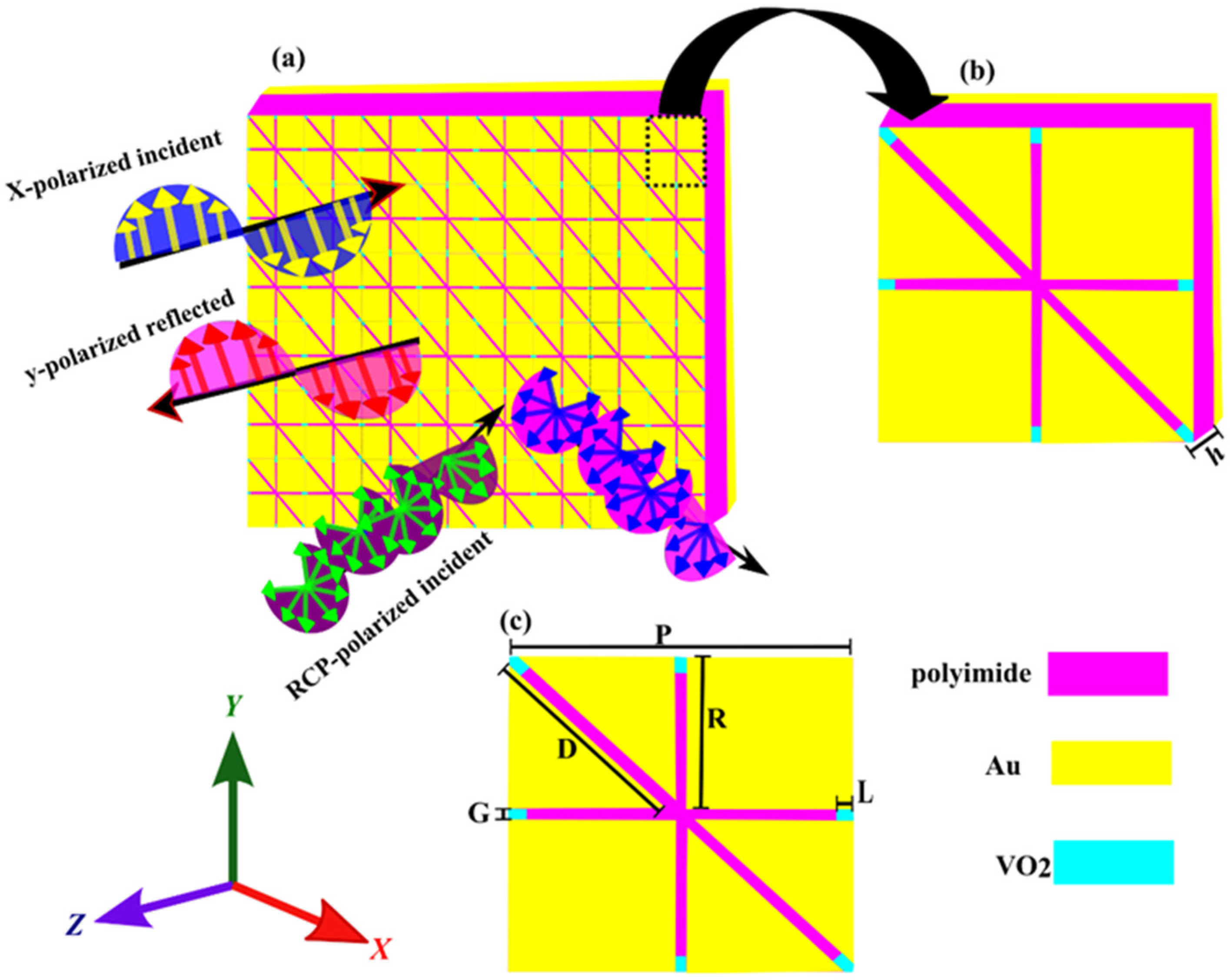
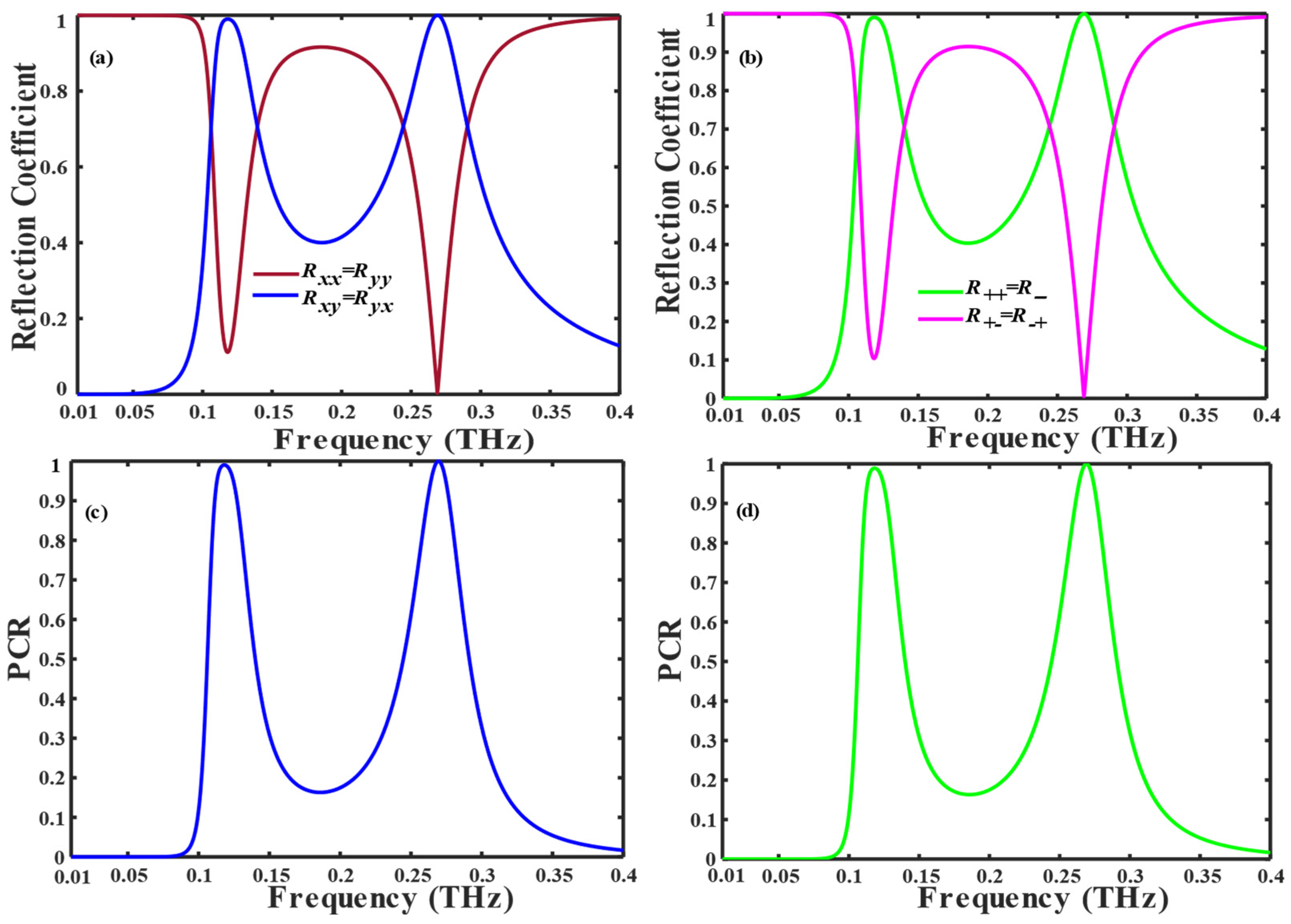

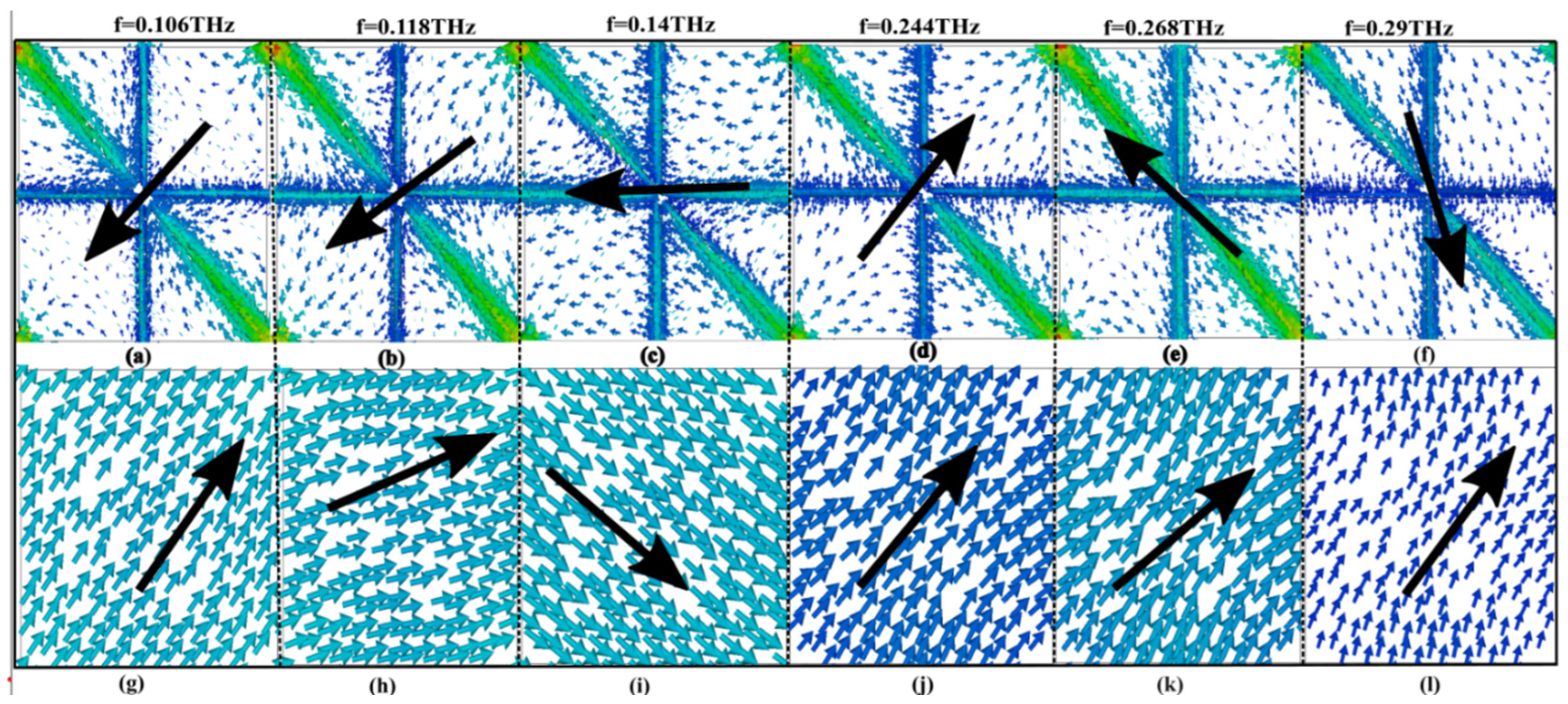

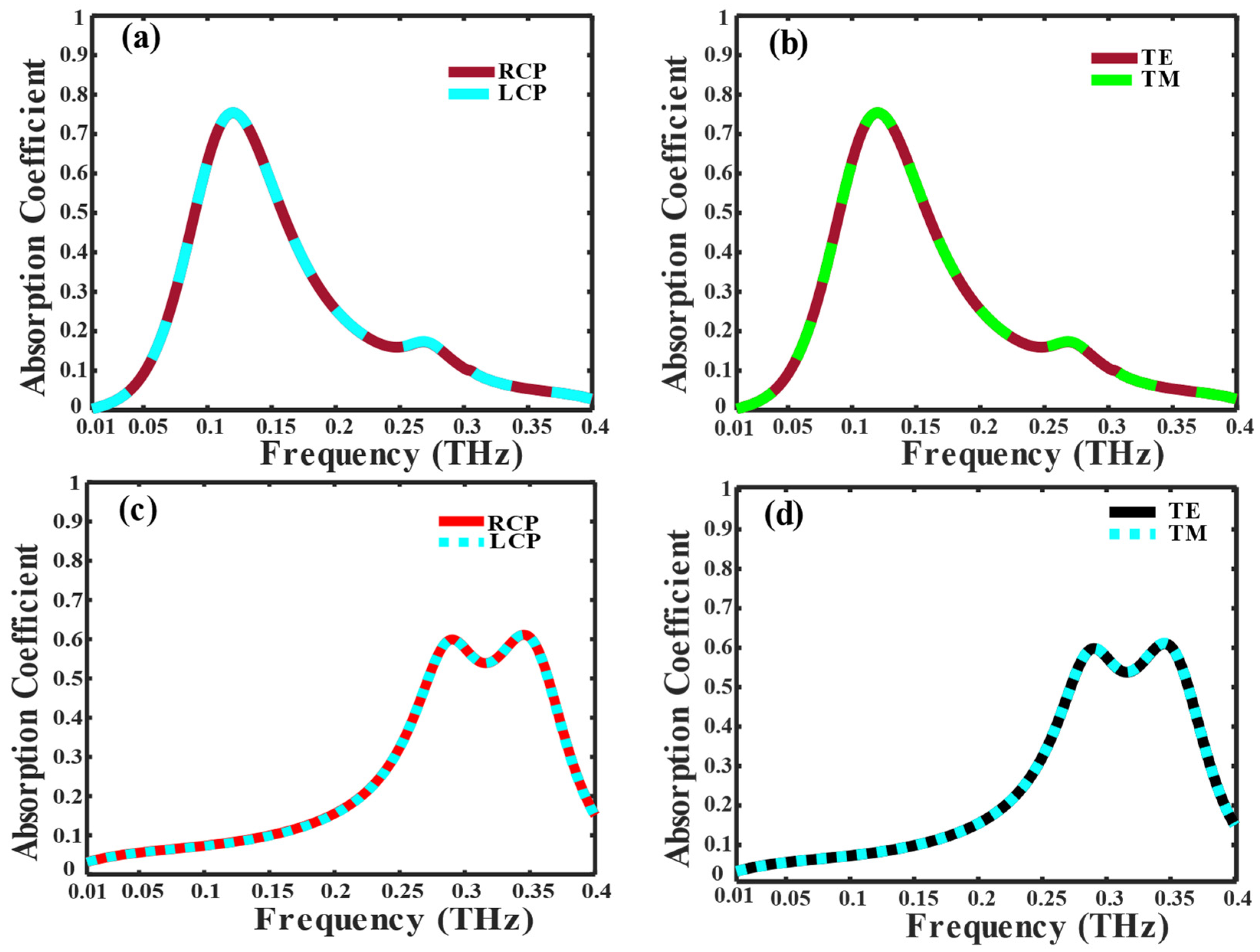
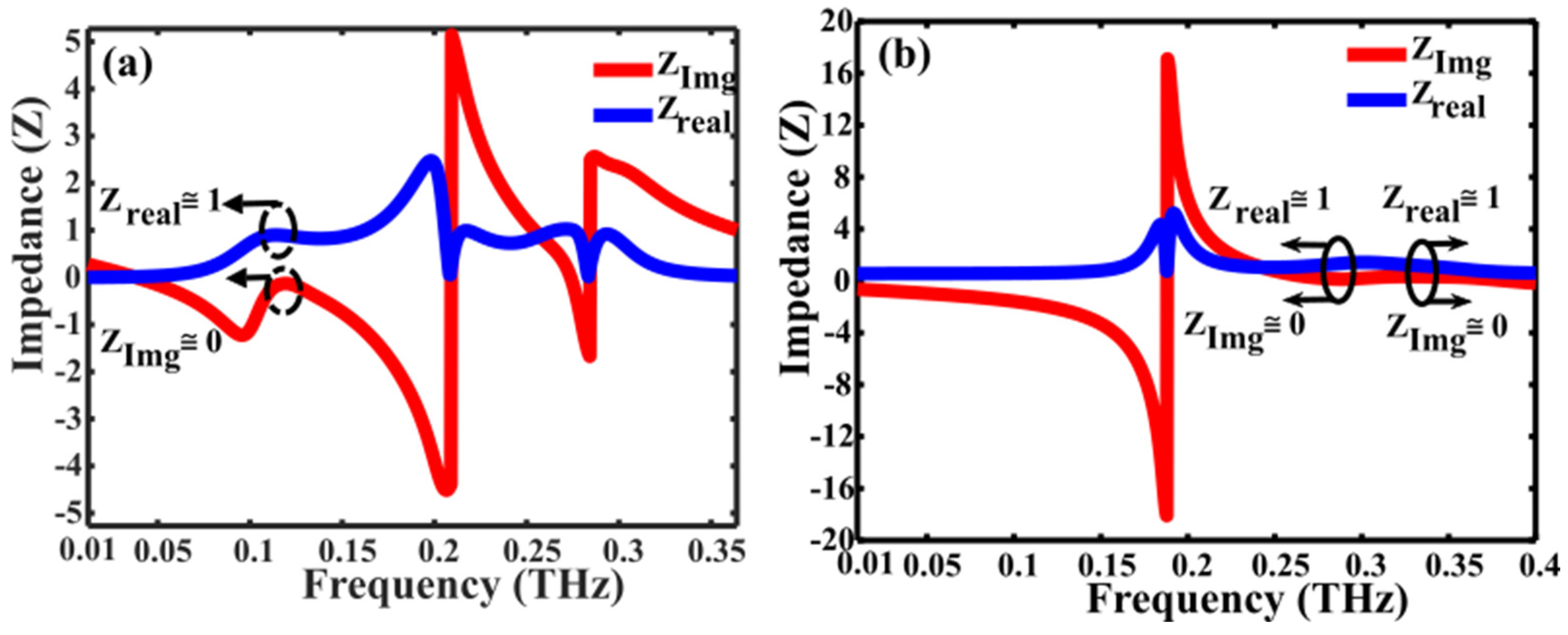
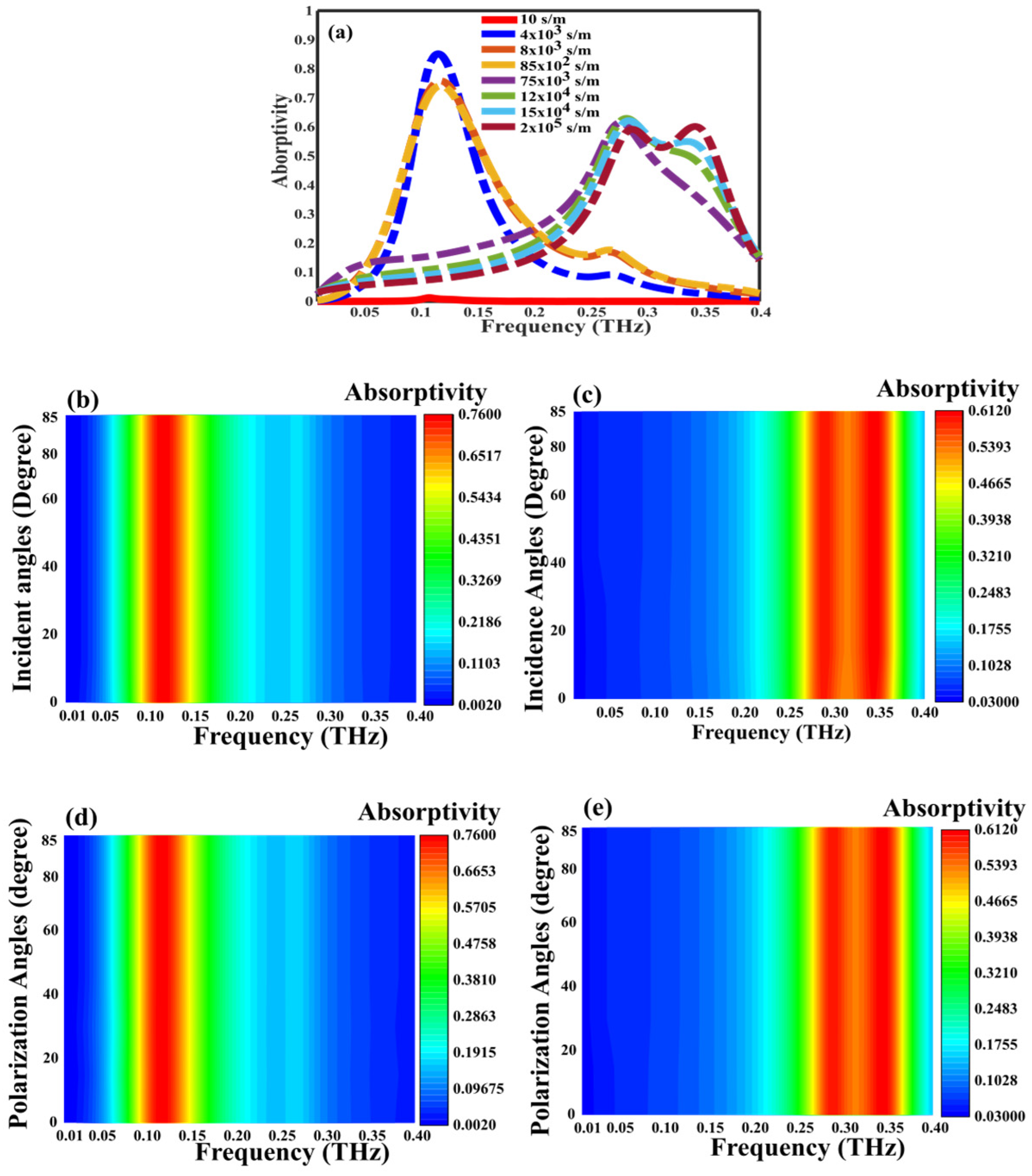
Disclaimer/Publisher’s Note: The statements, opinions and data contained in all publications are solely those of the individual author(s) and contributor(s) and not of MDPI and/or the editor(s). MDPI and/or the editor(s) disclaim responsibility for any injury to people or property resulting from any ideas, methods, instructions or products referred to in the content. |
© 2024 by the authors. Licensee MDPI, Basel, Switzerland. This article is an open access article distributed under the terms and conditions of the Creative Commons Attribution (CC BY) license (https://creativecommons.org/licenses/by/4.0/).
Share and Cite
Iqbal, R.; Qureshi, U.U.R.; Jie, C.; Rahman, Z.U.; Jafar, N. Polarization and Incident Angle Independent Multifunctional and Multiband Tunable THz Metasurface Based on VO2. Nanomaterials 2024, 14, 1048. https://doi.org/10.3390/nano14121048
Iqbal R, Qureshi UUR, Jie C, Rahman ZU, Jafar N. Polarization and Incident Angle Independent Multifunctional and Multiband Tunable THz Metasurface Based on VO2. Nanomaterials. 2024; 14(12):1048. https://doi.org/10.3390/nano14121048
Chicago/Turabian StyleIqbal, Rehmat, Ubaid Ur Rahman Qureshi, Cao Jie, Zia Ur Rahman, and Naveed Jafar. 2024. "Polarization and Incident Angle Independent Multifunctional and Multiband Tunable THz Metasurface Based on VO2" Nanomaterials 14, no. 12: 1048. https://doi.org/10.3390/nano14121048
APA StyleIqbal, R., Qureshi, U. U. R., Jie, C., Rahman, Z. U., & Jafar, N. (2024). Polarization and Incident Angle Independent Multifunctional and Multiband Tunable THz Metasurface Based on VO2. Nanomaterials, 14(12), 1048. https://doi.org/10.3390/nano14121048







